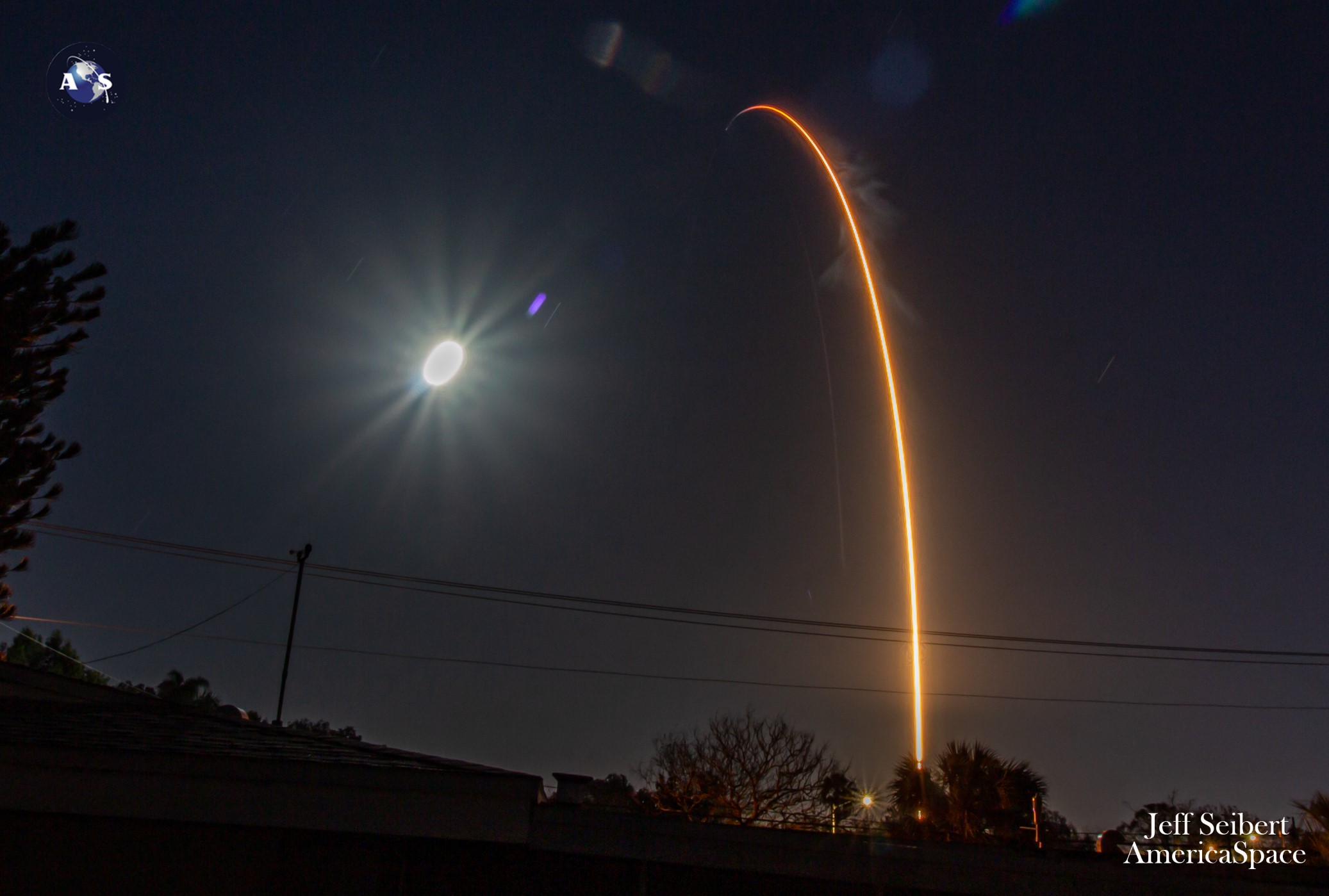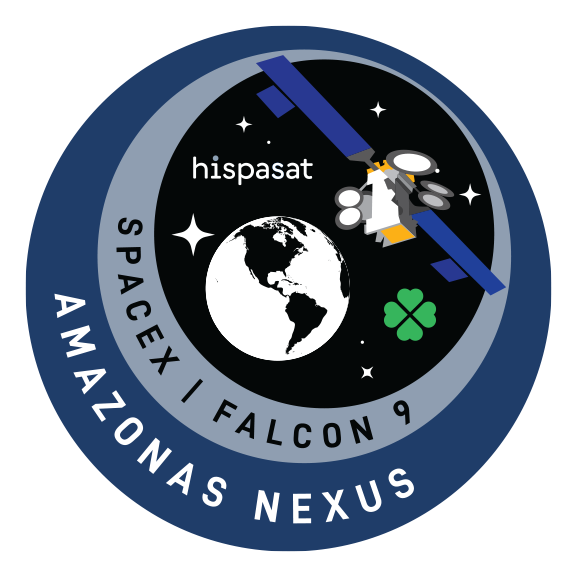
SpaceX is heading squarely towards its tenth launch inside 2023’s first six weeks, following the spectacular 8:32 p.m. EST Monday liftoff of a six-times-flown Falcon 9 booster from storied Space Launch Complex (SLC)-40 at Cape Canaveral Space Force Station, Fla. Riding the B1073 core—which was making her sixth launch in under a year, having entered SpaceX’s fleet only last May—was Hispasat’s Amazonas Nexus High Throughput Satellite (HTS), destined for emplacement into geostationary orbit to provide Ku-band and Ka-band coverage over the entirety of the American continents, as well as Greenland and air and maritime routes along the North Atlantic Corridor.
A highly pessimistic weather picture earlier in the weekend ultimately put paid to attempts to fly on Sunday evening, during a four-hour “launch window” from 5:32 p.m. EST through 9:32 p.m. EST, with conditions dipping as low as 30-percent-favorable. According to the 45th Weather Squadron at Patrick Space Force Base, Sunday’s primary concerns centered upon potential violations of the Cumulus Cloud Rule, the Thick Cloud Layers Rule and the Disturbed Weather Rule.
Video credit Jeff Seibert / AmericaSpace

“Showers and storms will push back into the area by tomorrow morning into the afternoon,” noted the 45th in its L-1 weather update on Saturday, adding that unsettled weather threatened the beginning of Sunday’s “launch window”. The forecast hovered as high as 55-percent-favorable and as low as just 30 percent.

With poorer conditions at the 5:32 p.m. EST opening of Sunday’s window, SpaceX targeted a revised T-0 at 7:32 p.m. EST, then aimed for the end of the four-hour window at 9:32 p.m. EST, before eventually a scrub was called. “Standing down from tonight’s Falcon 9 launch of the @Hispasat Amazonas Nexus mission,” the organization tweeted, “due to unfavorable launch and recovery weather conditions.”

Conditions were expected to improve to around 90 percent for Monday’s backup opportunity, with the arrival of “reinforcing high pressure” and a slight risk of a Cumulus Cloud Rule violation. For Monday, another four-hour window, also opening at 5:32 p.m. EST, was available, with SpaceX aiming for a T-0 point at 8:32 p.m. EST.
In readiness for launch, the Autonomous Spaceport Drone Ship (ASDS), “Just Read the Instructions”, put to sea out of Port Canaveral last Wednesday, bound for a recovery position some 390 miles (620 kilometers) offshore in the Atlantic Ocean. However, the 45th stressed that the risk to successfully recovering B1073 on Sunday was “High”, improving to “Low-Moderate” for a Monday launch attempt.

Primary payload aboard tonight’s flight was the 10,000-pound (4,500-kilogram) Amazonas Nexus High Throughput Satellite (HTS), a geostationary payload flying on behalf of Spain’s Hispasat for insertion into orbit at 61 degrees West longitude. Equipped with a new Digital Transparent Processor (DTP), Amazonas Nexus will replace the October 2009-launched Amazonas-2, which is nearing the end of its operational service life.
Contracts to build the Ku-band/Ka-band Amazonas Nexus were awarded to Thales Alenia Space in January 2020, leveraging its all-electric Spacebus Neo-200 to furnish a 20-kilowatt payload covering the entirety of the American continents, Greenland and air and maritime routes along the North Atlantic Corridor. Its fifth-generation DTP (described as its “main novelty” by Thales Alenia Space) will enhance its geographical flexibility should changes occur to initially proposed business scenarios, thus affording “great resilience to the evolution of the communications market, both in the field of connectivity and data and in the field of contents transmission”.

Targeting a minimum 15-year operational lifetime, Amazonas Nexus was initially scheduled to fly in the second half of 2022, but its launch has since slipped into early 2023. Financing of the satellite’s “space segment”—to cover launch services via a SpaceX Falcon 9 and initial on-orbit insurance—was concluded in June 2021, through an $80.7 million loan from the Export-Import Bank of the United States (EXIM).

Over the past three years, Hispasat has secured several commercial agreements for long-term leasing of transponder capacity aboard the satellite. Aviation broadband provider Gogo signed up to the project in January 2020 and Hispasat is also under contract to embed the U.S. Space Force’s 108-megahertz Pathfinder 2 on Amazonas Nexus. More recently, last September high-speed connectivity and entertainment provider Anuvu extended its contract for multi-transponder capacity at 61 degrees West, initially via Amazonas-2, but also with a future eye on Amazonas Nexus.
In December 2022, the satellite was transported from Thales Alenia Space’s facilities in Cannes, France and flown via an Antonov heavy airlifter from Aéroport de Nice to Cape Canaveral. After reaching the launch site, it was fueled and put through a battery of final tests, ahead of encapsulation in its Falcon 9 payload fairing.

Earmarked for tonight’s mission was B1073, which entered the SpaceX fleet in May 2022 and has already logged five launches, most recently last December when she lifted Japan’s Hakuto-R lunar lander, the United Arab Emirates (UAE) Rashid rover and NASA’s water-ice-seeking Lunar Flashlight. Across her career to date, she also delivered 157 Starlink low-orbiting internet communications satellites for SpaceX, as well as the heavyweight SES-22 geostationary communications satellite for Luxembourg-headquartered SES.
Following a smooth launch at 8:32 p.m. EST, B1073’s nine Merlin 1D+ engines powered the 230-foot-tall (70-meter) Falcon 9 uphill for the opening 2.5 minutes of flight, before separating from the stack and descending to an on-point touchdown on the deck of JRTI. The single Merlin 1D+ Vacuum engine of the second stage then picked up the baton, burning for six minutes, then entering a lengthy coast phase, ahead of deployment of Amazonas Nexus, targeted at just past 35 minutes into tonight’s mission.

According to Hispasat, the giant satellite’s next step will be its lengthy transfer to geostationary orbit, at an altitude of about 22,300 miles (35,700 kilometers), a journey which is expected to require up to six months. “Once there, the established tests will be carried out for several weeks to verify its correct operation,” Hispasat explained, “and, after that, it will be placed in its final orbital position at 61 degrees West, where it will replace and expand the capacity of Amazonas-2.”
Tonight’s launch marked the ninth SpaceX flight at the start of the year’s sixth week, an impressive achievement as CEO Elon Musk aims for up to a hundred missions in 2023. Eight Falcon 9 boosters—which have logged a total of 47 launches between them—have so far delivered more than 200 Starlinks, 40 broadband satellites for London, England-based OneWeb, the sixth Block III Global Positioning System (GPS) navigation and timing satellite and the 114-payload Transporter-6 rideshare mission, plus a triple-barreled Falcon Heavy also lifting USSF-67 for the U.S. Space Force.
Beyond Amazonas Nexus, February will also see Dragon Endeavour fly her fourth mission, carrying NASA astronauts Steve Bowen and Warren “Woody” Hoburg, Russian cosmonaut Andrei Fedyayev and Sultan Al-Neyadi of the United Arab Emirates (UAE) for a six-month ISS increment. The four men will launch from historic Pad 39A at Florida’s Kennedy Space Center (KSC) no earlier than 2:07 a.m. EST on 26 February, targeting a half-day, eight-orbit rendezvous and docking at the space-facing (or “zenith”) port of the station’s Harmony node.

Added to that list is the Inmarsat-6 F2 geostationary communications satellite on 18 February, a second pair of O3B mPOWER broadband satellites bound for Medium Earth Orbit (MEO)—following hard on the heels of a previous pair, lofted last December—and perhaps a pair of Maxar-built WorldView Legion satellites to Sun-synchronous orbit. The latter are expected to double Westminster, Colo.-based DigitalGlobe’s capacity to gather high-resolution geospatial imagery by resolving surface details as small as 12 inches (30 centimeters).






7 Comments
7 Pings & Trackbacks
Pingback:SpaceX Launches Hispasat’s Amazonas Nexus, First Commercial Geostationary Mission of 2023 – UK Poperty Guides
Pingback:SpaceX Launches Inmarsat-6 F2, Other GTO-Bound Missions Wait in Wings - AmericaSpace
Pingback:Three Falcon 9 Missions Lie Ahead, as CRS-27 Readies for Launch Tonight - AmericaSpace
Pingback:Three-Times-Flown Cargo Dragon Launches Science, Supplies to Space Station - AmericaSpace
Pingback:As SpaceX Lofts 40 OneWeb Satellites, Relativity Space Aims for Launch Attempt #2 on Saturday - AmericaSpace
Pingback:SpaceX Flies Hosted Mission for Intelsat & NASA, Heads for Year’s 25th Mission - AmericaSpace
Pingback:SpaceX Flies Year’s 25th Mission, Looks to Starship/Super Heavy Debut Tomorrow - AmericaSpace